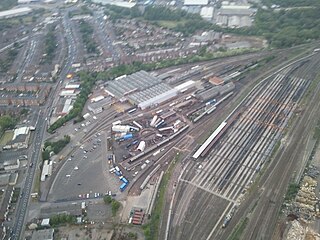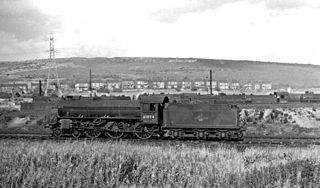
British Rail's Class 27 comprised 69 diesel locomotives built by the Birmingham Railway Carriage and Wagon Company (BRCW) during 1961 and 1962. They were a development of the earlier Class 26; both were originally classified as the BRCW Type 2. The Class 27s were numbered D5347-D5415.

The Class 110 diesel multiple units were built by the Birmingham Railway Carriage and Wagon Company in conjunction with the Drewry Car Co. to operate services on the former Lancashire and Yorkshire main line. They originally entered service uniquely in this region, which earned them the name of the 'Calder Valley' sets. They were an updated version of the Class 104, with more powerful engines, a revised cab design and raised bodyside window frames.

St Blazey engine shed is located in Par, Cornwall, United Kingdom, although it is named after the adjacent village of St Blazey. It was built in 1874 as the headquarters of the Cornwall Minerals Railway but for many years was a depot of the Great Western Railway. The current depot operator is DB Cargo and the depot TOPS code is BZ.

Laira T&RSMD is a railway traction and rolling stock maintenance depot situated in Plymouth, Devon, England. The depot is operated by Great Western Railway and is mainly concerned with the overhaul and daily servicing of their fleet of High Speed Trains and also the DMUs used on local services. The depot code "LA" is used to identify rolling stock based there.

Tyseley TMD is a railway traction maintenance depot situated in Tyseley, Birmingham, England.

Exeter Traction Maintenance Depot is a railway Traction Maintenance Depot situated in Exeter, Devon, United Kingdom and is next to the city's main St Davids station. The depot is operated by Great Western Railway and has an allocation of diesel multiple units.

Botanic Gardens TMD is a traction maintenance depot in Kingston upon Hull in Yorkshire, England. As built it was one of the principal steam engine sheds in the Hull area, Botanic Gardens was the one closest to the main Hull Paragon station and its locomotives were responsible for working passenger services in the area. This entry also covers the engine sheds in the Paragon area that preceded Botanic Gardens.
Colchester engine shed was a motive power depot located in Colchester in the county of Essex in the UK. The original depot dated back to the opening of the Eastern Counties Railway (ECR) in 1843 and a second engine shed was built following the opening of the Eastern Union Railway in 1846. The ECR shed closed and the EUR shed was in use until November 1959 when the line was electrified and Colchester station rebuilt. A smaller two track engine shed was provided south of the station and after closure in the 1990s it was used for the stabling of diesel and electrical multiple units. It is currently known as Colchester Carriage Servicing Depot and units can be washed externally and cleaned internally on site.

Newport Ebbw Junction TMD was a traction maintenance depot located in Newport, Wales. The depot was situated on the Ebbw Valley Railway and was near Newport railway station.
Hamilton TMD was a traction maintenance depot located in Hamilton, South Lanarkshire, Scotland. The depot was situated on the Argyle Line and was near Hamilton West station.
Llandudno Junction TMD was a traction maintenance depot located in Llandudno, Conwy, Wales. The depot was situated on the Conwy Valley Line and was near Llandudno Junction railway station.

Lincoln TMD was a traction maintenance depot located in Lincoln, Lincolnshire, England. The depot was situated on the south side of the Lincoln to Grimsby line and was to the east of Lincoln Central station.

Bedford Carriage Sidings are located in Bedford, Bedfordshire, England on the Midland Main Line, near Bedford station.
Westbury DMU Servicing Depot is a traction maintenance depot located in Westbury, Wiltshire, England. The depot is situated on the Reading to Taunton line and is near Westbury station.

Wellingborough Loco Shed was a stabling point located in Wellingborough, Northamptonshire, England. The depot was situated on the Midland Main Line and was located just north of Wellingborough station.
Southall DMU Depot was a traction maintenance depot located in Southall, London, England. The depot is situated on the Great Western Main Line and is near Southall station.
Thornton Junction TMD was a traction maintenance depot located in Thornton, Fife, Scotland. The depot is situated on the Fife Circle Line and was near Thornton Junction station until it closed.
Radyr Motive Power Depot was a traction maintenance depot located in Radyr, Cardiff, Wales. The depot was situated on the Merthyr Line and was near Radyr station.

Canklow Engine Shed was a traction maintenance depot located in Canklow, Rotherham, England. The depot opened in 1900 and was situated on the Midland Main Line, 1.5 miles (2.4 km) south of Rotherham Masborough station. The depot area had six lines; three of these fed into just one line that went through the shed, whilst the other three were sidings, one of which had the coal stage.
Manningham Engine Shed was a railway depot located in the Manningham suburb of Bradford in West Yorkshire, England. The depot was built to provide steam engines for services leaving Bradford Forster Square station and freight traffic from the Valley Road area of the city. It was also responsible for other sites at Keighley and Ilkley with Manningham itself being a sub-shed of Holbeck.













